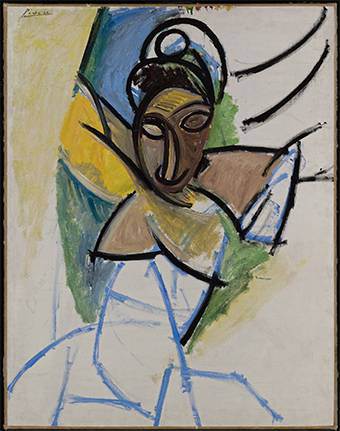
Pablo Picasso
Femme, 1907
Beyeler Foundation, Basel, Switzerland
Picasso’s ‘Femme’ on loan to the Getty Museum Pablo Picasso’s 1907 painting ‘Femme’ from the Beyeler Foundation in Switzerland is on temporary display at the J. Paul Getty Museum from January through March 2015.]]>
January 4, 2015, source: Getty Museum
The painting, which closely relates to Picasso’s famed “Les Demoiselles d’Avignon” (1907, Museum of Modern Art, New York), will hang in the Getty Museum’s West Pavilion alongside portraits by Edouard Manet and Paul Cézanne, 19th-century masters whom Picasso greatly admired.
“This work represents a pivotal moment in Picasso’s career, marking the first experiments with fractured space that culminated in his revolutionary painting ‘Les Desmoiselles D’Avignon’ of the same year and the creation of cubism,” says Timothy Potts, director of the J. Paul Getty Museum. “Thanks to our Conservation Partnership Program and the support of the Getty Museum Paintings Council, over the next three months our visitors will have a unique opportunity to experience one of the landmark moments in modern art as if it were still happening ─ the fractured composition still carving itself into space around the woman’s head and the blocks of color still being laid out in form-defying blocks. Even alongside our Impressionist and Post-Impressionist masterpieces, this striking work of modern art is a commanding presence that announces in explosive and uncompromising terms that a new approach to painting has arrived.”
“Femme” was created while Picasso was working on his masterwork “Les Demoiselles d’Avignon”, a notorious brothel scene that stands out as a radical break from his earlier blue and rose periods. In this painting, Picasso’s burgeoning interest in compressed divided space and African masks is fully evident.
“Femme” is part of the collection of the Beyeler Foundation in Basel, Switzerland and was brought to the Getty by their chief conservator, Markus Gross, who spent three months doing research related to the painting, working with Getty Museum conservators and Getty Conservation Institute scientists, to develop a conservation protocol for the work. When the painting returns to the Beyeler Foundation in Switzerland, Gross and his team will use the conservation protocols developed at the Getty to guide future work on the painting. While at the Getty, “Femme” was extensively studied using x-radiography, ultraviolet light, and multi-spectral imaging, among other techniques.
Related content
Picasso’s “Femme” leads Sotheby’s London auction (news, February 2013)
Follow us on:


